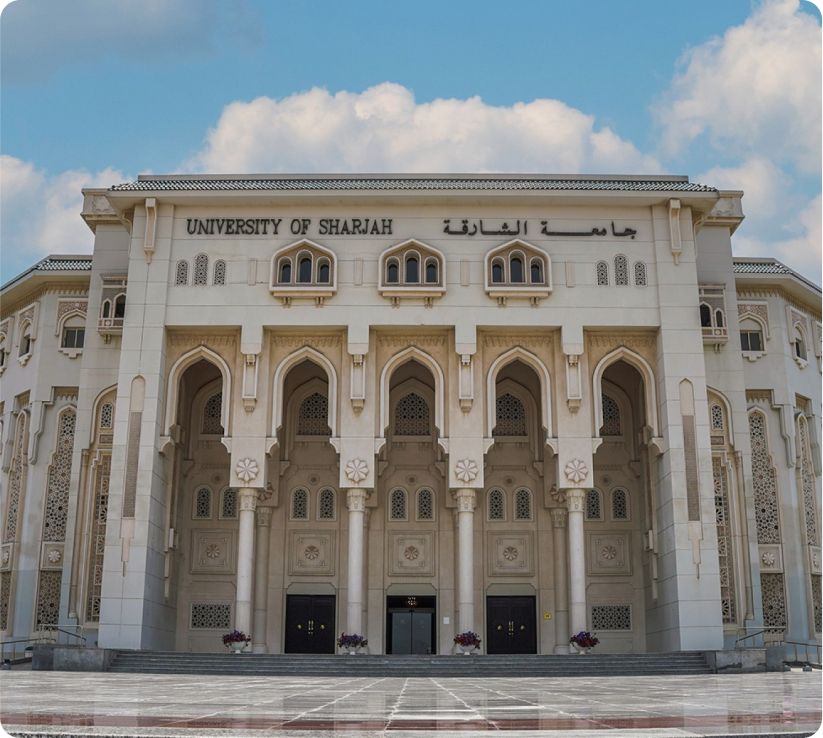Degree Structure
College
Sciences
Department
Applied Physics and Astronomy
Level
Graduate Masters
Study System
Courses and Theses
Total Credit Hours
33 Cr. Hrs.
Duration
2-4 Years
Intake
Fall and Spring
Language
English
Study Mode
Full Time and Part Time
Begin your academic journey with our user-friendly online application platform.
Important Dates
Get access to expert guidance.

Degree Overview
Sustainable development, land use planning and environmental monitoring is widely recognized and depends greatly on the availability and credibility of geospatial data such as digital maps, terrestrial surveys, aerial photographs and satellite imagery. The methods required for these types of investigations and analysis of the resulting databases, which link information to maps stored in digital form, constitute the field of Geographical Information Systems and Remote Sensing (GISRS). The application of GISRS in the UAE Governmental and private agencies is of high demand, this include Road and Transport Authority, Ministry of Public Works, Ministry of Environment and Water, Ministry of Energy and other Environmental agency as well as Municipalities. Extraordinary demands are also required from national and International Oil and Gas, Civil Engineering and Construction Industry as well as Academic and Educational Institutions.
University of Sharjah is well recognized as one of the leading centers in the area in the field of GISRS and related technologies (including spatial and non-spatial data survey, remote sensing, photogrammetry, Global Positioning Systems (GPS), and digital mapping. For the University of Sharjah, the MSc in GISRS is an inherent component of the integrative geospatial initiative that includes the following existing components:
- B.Sc. in Petroleum Geology and Remote Sensing
- M.Sc. & BSc in Civil and Environmental Engineering
- Computer Science
- GIS and Remote Sensing Center at Research Institute of Science and Engineering (RISE)
- Research Projects (RISE)
Despite the considerable demand for geoscientists in the UAE and the GCC region, there is only one graduate program offered by another university in the UAE. Furthermore, the proposed program will offer concentrations not offered by other programs, such as science and engineering where graduates from the proposed program will find employment opportunities covering a wide spectrum mainly in environmental monitoring, transportation, mineral and water exploration, geo-imaging and remote sensing, natural risks management, industry and petroleum sectors, archaeological excavation and preservation, business as well as research positions in industry and government laboratories.
The Master of Science GISRS is designed to provide the students with multidisciplinary knowledge and skills required for working in a wide range of careers that deals with geospatial data and applications. Moreover, the proposed program aims at establishing a geospatially-centered teaching and research environment and providing world-class knowledge and expertise for multi-disciplinary research in Engineering, Computer, Environmental, Social and Earth Sciences, Sustainable Development, as well as Information and Data Management Technologies.
What You Will Learn
Upon the successful completion of the program, students will be able to:
- Explain the scientific and theoretical concepts of geospatial data analysis and modelling.
- Acquire process, analyze geospatial data, and appropriately display results.
- Apply GIS and RS knowledge and algorithms in solving environmental, urban, social and economic problems.
- Communicate both research and analysis results orally and in writing.
- Develop independent and collaborative research and conduct critical literature analysis.
- Identify the legal and ethical principles that govern geospatial profession and research work.
University Requirements
College Requirements
Degree Requirements
Program Structure Requirements
|
Requirement |
Credit Hours |
|
Compulsory Courses |
15 |
|
Elective Courses |
9 |
|
Thesis |
9 |
|
Total Credit Hours |
33 |
Course List
Compulsory courses (Thesis Options):
|
No. |
Course Code |
Course Title |
Cr. Hrs. |
Pre-requisite(s) |
|
1 |
1470515 |
GIS and Remote Sensing Fundamentals |
3 |
Grad. Standing |
|
2 |
1470532 |
GIS Programming Fundamentals |
3 |
Grad. Standing |
|
3 |
1470512 |
Digital Cartography and Visualization |
3 |
Grad. Standing |
|
4 |
1470511 |
Spatial Statistics |
3 |
1470515; 1470512 |
|
5 |
1411566 |
Database Design and Development |
3 |
Grad. Standing |
|
6 |
1470541 |
Thesis Proposal |
0 |
|
|
7 |
1470542 |
Master's Thesis |
9 |
|
|
Total |
21 |
Electives Courses:
|
No. |
Course Code |
Course Name |
Cr. Hrs. |
Prerequisites |
|
1 |
1470521 |
Geodesy and Digital Photogrammetry |
3 |
1470515; 1470512 |
|
2 |
1470513 |
GIS for Urban Planning |
3 |
1470515; 1470512 |
|
3 |
0401582 |
GIS for Transportation |
3 |
1470511 |
|
4 |
1470522 |
Digital Terrain Modeling |
3 |
1470511 |
|
5 |
0401581 |
GIS and Remote Sensing for Environmental Studies |
3 |
1470515; 1470512 |
|
7 |
1470514 |
Geospatial Project Management* |
3 |
1470515; 1470512 |
|
8 |
1470533 |
Web and Mobile GIS Applications |
3 |
1470532, 1411566 |
|
9 |
1411553 |
Spatial Algorithms and Distributed Programming |
3 |
1470532, 1411566 |
|
10 |
1411568 |
Big Data and Data Analytics |
3 |
1470532, 1411566 |
Course Description
Compulsory Courses Descriptions
| 1470515 | GIS and Remote Sensing Fundamentals | (3-0:3) |
|
Prerequisite: Graduate Standing This course is designed as an introduction to Geographical Information Systems (GIS) and remote sensing students. It introduces students to the concepts and fundamentals of GIS and Remote sensing with reference to a diverse range of applications. Topics covered include in this course, Part I: Data capturing techniques, spatial data models and structures, spatial reference system, spatial analysis and raster spatial analysis, part II; electromagnetic spectrum, satellite platforms and imaging, image interpretation and radiometric enhancement, geo-referencing and geometric correction, multi-band operations and supervised and unsupervised classification. The course will allow students to capture and analyze spatially referenced data and satellite images, and communicate results obtained using GIS and remote sensing data. The course includes a lab for hands-on training with GIS and remote sensing software. |
||
| 1470532 | GIS Programming Fundamentals | (3-0:3) |
|
Prerequisite: Graduate Standing This course explains principles, syntax, and language elements associated with creating and running computer programming scripts for create GIS applications. Python scripting is used to efficiently run ArcGIS tools, read text files of data and ArcGIS attribute tables, applying vector data algorithms for GIS visualization, interact with map elements, manipulate batches of GIS data, and create basic user interfaces. Raster, network and surface data algorithms for GIS will also be introduced. Students completing this course should be able to implement a simple GIS workflow and build generalized application. |
||
| 1470512 | Digital Cartography and Visualization | (3-0:3) |
|
Prerequisite: Graduate Standing The course provides an introduction on modern cartographic and modern geo-visualization techniques. It begins with the fundamentals of map design and data graphics and then introduces the principles of interaction design and geospatial information visualization. Topic covered in this course include map production workflow and quality management; Topographic information production; Thematic and interactive web mapping; Web cartography and mapping projects. The course delivers solid grounding in the design of cartographic interfaces for traditional static maps, interactive or exploratory computer interfaces to geospatial data. |
||
| 1470511 | Spatial Statistics | (3-0:3) |
|
Prerequisite: 1470515; 1470512 This course introduces students to quantitative analysis of spatial data. It is intended to provide students with various spatial statistic methods useful in engineering and science with the background necessary to investigate geographically represented data. Examples of topics covered in the course include point pattern analysis; area data analysis; continuous data analysis; spatial sampling; and multivariate spatial and temporal analysis. In this course theories, methods, and applications is included to help students develop an understanding of the important theoretical concepts in spatial statistical analysis and gain practical experience in applying spatial statistics methods and algorithms using various statistical software. |
||
| 1411566 | Database Design & Development | (3-0:3) |
|
Prerequisite: Graduate Standing This course explores how geodatabases are designed, implemented and used. The students will learn the relational model, the relational Algebra, and SQL, functional dependencies and normal forms. Then, the students will be exposed to more advanced topics and implementation related aspects of database management systems such as object databases, file structures, GIS indexing, query optimization, transaction processing, concurrency control, and database recovery. |
||
| 1470514 | Geospatial Project Management* | (3-0:3) |
|
Prerequisite: 1470515; 1470512 This course takes a systematic approach to explore the management issues and methods necessary for developing a geospatial technology project. Topics covered in the course include: the typical project life cycle; program planning and development; popular organizational structures; financial management; the technical and operational environment, and communications; the fundamentals involved in completing a successful project on time and on budget by examining a variety of topics associated with funding, financial management, monitoring and reporting, risk management; multi‐ organizational agreements (collaborations); the various approaches needed to manage the technical design (system configuration, data, applications); the various roles played by people in geospatial technology projects, covering topics associated with project leadership, team building and capacity building, among others; some of the legal and ethical considerations that may influence geospatial technology projects and their outputs. * The course 1470514 Geospatial Project Management is Compulsory only for the Non-thesis option. |
||
| 1470541 | Thesis Proposal | (0-0:0) |
|
Prerequisite: The student has to undertake and complete a research topic under the supervision of a faculty member. The Thesis work The rules regulating the registration for the Thesis are detailed in the University's rules and regulations of Graduate Studies Guide. |
||
| 1470542 | Master Thesis | (0-0:9) |
|
Prerequisite: Graduate Standing The student has to undertake and complete a research topic under the supervision of a faculty member. The thesis work should provide the student with in-depth perspective of a particular research problem in his chosen field of specialization. It is anticipated that the student be able to carry out his research fairly independently under the direction of his supervisor. The student is required to submit a final thesis documenting his research and defend his work in front of a committee. |
||
Elective Courses Descriptions
| 1470521 | Geodesy and Digital Photogrammetry | (3-0:3) |
|
Prerequisite: 1470515; 1470512 This course introduces students to various elements of Geodesy and photogrammetry. The first part of this course is an intensive introduction to the theory and practice of positioning (navigating, mapping and surveying) using Global Positioning System (GPS). The Second part is intended to provide students with theory of photography, photographic materials, photogrammetric optics and their physical properties for imaging systems. This include Photogrammetric sensing systems; mathematical concepts of photogrammetry; resection, intersection and triangulation; Digital image processing; Digital elevation models and Orthophoto generation. |
||
| 1470513 | GIS for Urban Planning | (3-0:3) |
|
Prerequisite: 1470515; 1470512 Urban and regional planners utilize GIS and RS to help find solutions to the challenges posed by increasing population growth and urban development. This course covers basic urban and regional planning concepts and tasks and teaches how those tasks can be managed using GIS techniques. Students learn how to use GIS tools to address real-world social, economic, and environmental planning problems such as urbanization, infrastructure development, transportation, air pollution, energy, and smart city. The skills and techniques presented in the course provide an effective and efficient means of carrying out urban and regional planning tasks. |
||
| 0401582 | GIS for Transportation | (3-0:3) |
|
Prerequisite: 1470511 This course introduces students to GIS fundamentals, data, and applications that have been developed for the field of transportation, collectively known as GIS-T. Examples of topics covered in the course include: importance and history of GIS-T; linear network concepts and topology; linear referencing systems and dynamic segmentation; GIS-T data models and data management; network analysis and minimum path routing; applications covering the various modes of transportation; current directions, cross-cutting issues and evolving technologies. |
||
| 1470522 | Digital Terrain Modeling | (3-0:3) |
|
Prerequisite: 1470511 This course focuses on the generation, analysis, classification and application of digital elevation models (DEMs) in combination with remotely sensed data on environmental topics like landform distribution, slope hazards and other processes. Emphasis will be on mathematical techniques used in the acquisition, processing, storage, manipulation, and applications of DTM. For example, display and analysis of girded data and irregularly spaced data; distribution of points; computer contouring; trend surfaces using polynomials functions and Surface representation by moving averages and kriging. |
||
| 0401581 | GIS and Remote Sensing for Environmental Studies | (3-0:3) |
|
Prerequisite: Graduate Standing Emphasizes on defining the features of environmental problems and conduct environmental investigations in geospatial context, integrated utilization of remote sensing alongside spatial (GIS) data technologies and simulation models for better understanding and managing the natural environment. The first part of the course will cover the remote sensing techniques to analyze and process remote sensing imagery. The second part of the course will focus on the application of remote sensing imagery and data, specifically Multispectral, Thermal Infrared and LiDAR (Light Detection and Ranging) for environmental and Hazard monitoring and mapping. |
||
| 1470514 | Geospatial Project Management* | (3-0:3) |
|
Prerequisite: 1470515; 1470512 This course takes a systematic approach to explore the management issues and methods necessary for developing a geospatial technology project. Topics covered in the course include: the typical project life cycle; program planning and development; popular organizational structures; financial management; the technical and operational environment, and communications; the fundamentals involved in completing a successful project on time and on budget by examining a variety of topics associated with funding, financial management, monitoring and reporting, risk management; multi‐ organizational agreements (collaborations); the various approaches needed to manage the technical design (system configuration, data, applications); the various roles played by people in geospatial technology projects, covering topics associated with project leadership, team building and capacity building, among others; some of the legal and ethical considerations that may influence geospatial technology projects and their outputs. * The course 1470514 Geospatial Project Management is elective only for the thesis option. |
||
| 1470533 | Web and Mobile GIS Applications | (3-0:3) |
|
Prerequisite: 1470532, 1411566 This course aims to provide students with the essential web GIS knowledge needed for managing web GIS projects, teach students the latest web GIS technologies needed for building modern web GIS apps, and inspire students with real world application case studies. In this course students will learn to format web mapping applications to deal with small screens, touch screens, and screens with varying sizes. They will also learn how to take advantage of the GPS sensor on mobile devices, store data and board, create an application cache so the application can be loaded off-line, and create custom base maps that can be used off-line. |
||
| 1411553 | Spatial Algorithms and Distributed Programming | (3-0:3) |
|
Prerequisite: 1470532, 1411566 A distributed GIS system is a software system in which components located on networked computers communicate and coordinate their actions by passing messages. The components interact with each other in order to achieve a common goal. Distributed applications (distributed apps) are applications or software that runs on multiple computers within a network at the same time and can be stored on servers or with cloud computing. This course provides an in-depth understanding of fundamental principles and models underlying the theory, algorithms, and systems aspects of distributed computing and their applications in GIS, and Remote Sensing. Few Emerging topics such as Peer-to-Peer computing, Distributed Hash Table, Google File System, HDFS, Spark, Sensor Networks and Security in Distributed Systems will also be covered for significant impact. Upon completing this course, students will have intimate knowledge about how things work in a GIS distributed environment. |
||
| 1411568 | Big Data and Data Analytics | (3-0:3) |
|
Prerequisite: 1470532, 1411566 Big geospatial data is becoming one of the most important technology that enables organizations to store, manage, and manipulate vast amounts of spatial data efficiently to gain business insights. Big data course provides the fundamentals, technologies, and tools to understand and apply the following the Big Data analytics in the field of GIS and remote sensing. Topics covered are Big Data types, technologies, analytical tools, numerical, textual, image and stream analysis, and applications of Big geospatial Data and remote sensing. |
||
Career Path

How will you make an impact?
Every student’s journey at UoS and beyond is different, which is why our Career & Professional Development team provides personalized career resources to help students make an impact for years to come.




